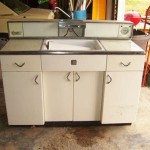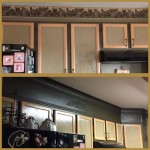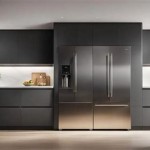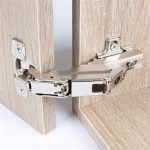Best Kitchen Wood Cabinet Cleaner
Maintaining the elegance and durability of wooden kitchen cabinets requires diligent cleaning and care. Choosing the right cleaning product is crucial for preserving the finish and preventing damage. This article explores effective cleaning solutions and best practices for achieving sparkling clean wooden kitchen cabinets.
Understanding Your Cabinets
Before selecting a cleaner, it is essential to identify the type of finish on the cabinets. Different finishes require specific cleaning approaches. Common cabinet finishes include:
- Painted Wood: Cabinets with a painted finish are generally more durable and can withstand slightly stronger cleaners.
- Stained Wood: Stained cabinets showcase the natural wood grain and require gentle cleaning to avoid discoloration or damage to the stain.
- Lacquered or Varnished Wood: These finishes provide a protective layer over the wood and need specific cleaners to maintain their sheen.
- Laminate Wood: Laminate cabinets are resistant to scratches and stains, allowing for more versatile cleaning options.
Choosing the Right Cleaner
The best cleaner for wood kitchen cabinets depends on the type of finish and the level of cleaning required. Options include:
- Mild Dish Soap and Water: This is a safe and effective option for regular cleaning of most cabinet finishes. Mix a few drops of dish soap with warm water and use a soft cloth to wipe down the cabinets. Rinse with clean water and dry thoroughly.
- White Vinegar and Water: This natural cleaning solution is ideal for removing grease and grime. Mix equal parts white vinegar and water in a spray bottle. Spray onto the cabinets and wipe clean with a soft cloth. Avoid using vinegar on unfinished or waxed wood.
- Commercial Wood Cleaners: Several commercial cleaners are specifically formulated for wood cabinets. Choose a cleaner that is appropriate for the cabinet's finish and follow the manufacturer's instructions carefully.
- Baking Soda Paste: For stubborn stains or sticky residue, create a paste by mixing baking soda with a small amount of water. Apply the paste to the affected area and gently rub with a soft cloth. Rinse thoroughly and dry.
Effective Cleaning Techniques
Proper cleaning techniques are essential for protecting the integrity of wooden kitchen cabinets. Consider these helpful tips:
- Test in an Inconspicuous Area: Before applying any cleaner to the entire cabinet surface, test it in a hidden area to ensure it does not damage the finish.
- Avoid Excessive Water: Excessive moisture can warp or damage wood. Use a damp cloth, not a soaking wet one, and dry the cabinets immediately after cleaning.
- Wipe with the Grain: Wiping with the wood grain helps prevent streaks and scratches.
- Avoid Abrasive Cleaners and Tools: Harsh chemicals and abrasive scrubbing pads can scratch and dull the finish of wood cabinets. Use soft cloths or sponges for cleaning.
Regular Maintenance for Long-lasting Beauty
Regular maintenance is key to keeping wooden kitchen cabinets looking their best. Incorporate these practices into your cleaning routine:
- Dust Regularly: Dusting cabinets weekly with a soft cloth helps prevent buildup and reduces the need for frequent deep cleaning.
- Address Spills Immediately: Wiping up spills promptly prevents stains and sticky residue from setting in.
- Protect from Excessive Moisture: Use a range hood while cooking to minimize grease and moisture buildup on cabinets near the stove.
- Consider Wood Polish: Occasionally using a wood polish designed for your cabinet's finish can help restore shine and protect the wood.
Dealing with Stubborn Stains
Certain stains may require specialized cleaning methods. Exercise caution when using stronger cleaning solutions:
- Grease Stains: Mix a solution of warm water and dish soap or a degreasing cleaner. Apply to the stain and let it sit for a few minutes before wiping clean.
- Water Stains: Light water stains can often be removed by rubbing the area with a soft cloth dipped in mayonnaise or baking soda paste.
- Ink Stains: Try rubbing the ink stain with a soft cloth dampened with rubbing alcohol or nail polish remover (test in an inconspicuous area first).
Protecting Cabinet Hardware
Cabinet hardware can also accumulate grime and tarnish over time. Specific cleaning approaches are often necessary:
- Remove Hardware for Cleaning: If possible, remove the hardware before cleaning the cabinets to ensure thorough cleaning of both the hardware and the cabinet surface.
- Clean with Appropriate Cleaners: Use a cleaner suitable for the hardware material (e.g., brass, nickel, chrome). Mild dish soap and water or a specialized metal cleaner are often effective.
- Dry Thoroughly: Dry hardware thoroughly after cleaning to prevent water spots or rust.
Professional Cleaning Services
For deep cleaning or restoration of heavily soiled or damaged cabinets, consider engaging professional cleaning services. Professionals possess the expertise and specialized tools to handle delicate finishes and address complex cleaning challenges.

We Tried 5 Methods To Clean Greasy Wood Cabinets And The Winner Is Ridiculously Effective Kitchn Cleaning Kitchen

How To Clean Kitchen Cabinets Everyday Skate

How To Clean Wood Kitchen Cabinets Like A Boss Shelfgenie

How To Clean Kitchen Cabinets 9 Basics Bob Vila

How To Clean Kitchen Cabinets Best Wood Cabinet Cleaners Cabinetdoors Com

How To Clean White Kitchen Cabinets 3 Best Ways Avoid Abbotts At Home

How To Clean Wood Cabinets

How To Clean White Kitchen Cabinets 3 Best Ways Avoid Abbotts At Home

The Ultimate Guide To Cabinet Care Doors N More

The Very Best De For Kitchen Cabinets And How To Use It Flooring Girl
Related Posts








